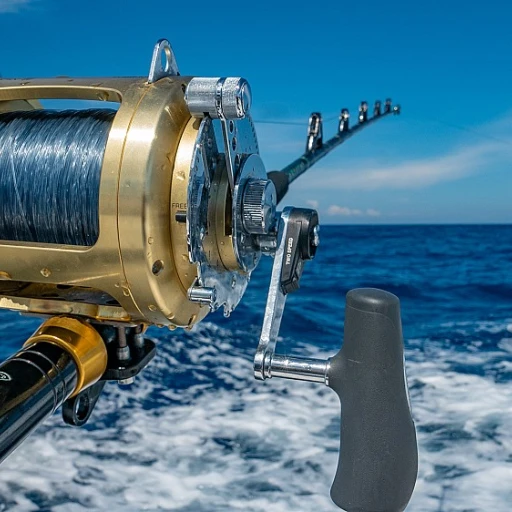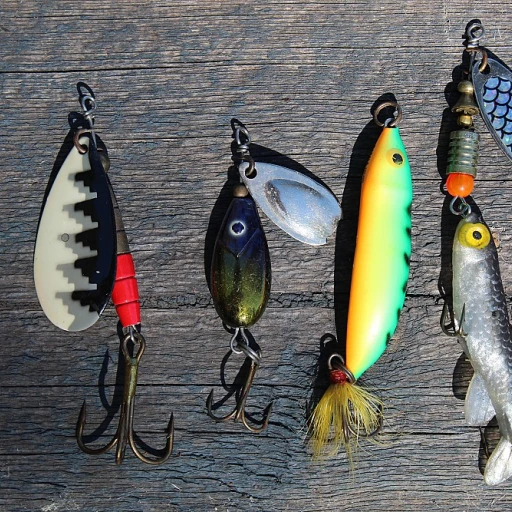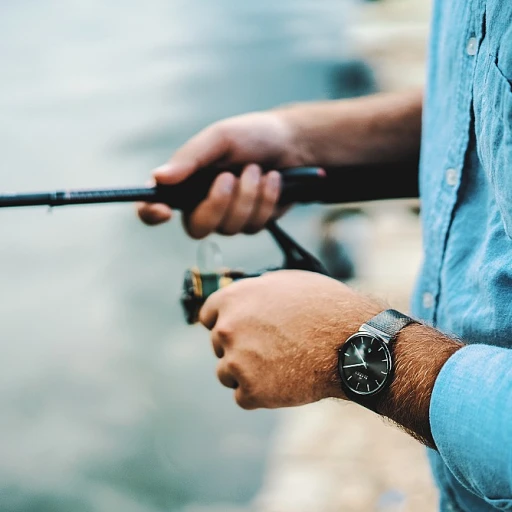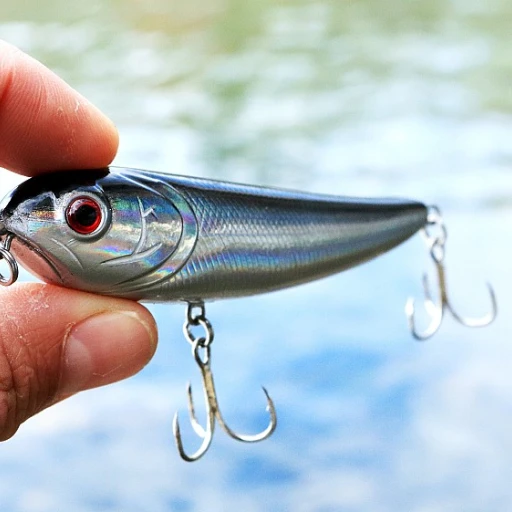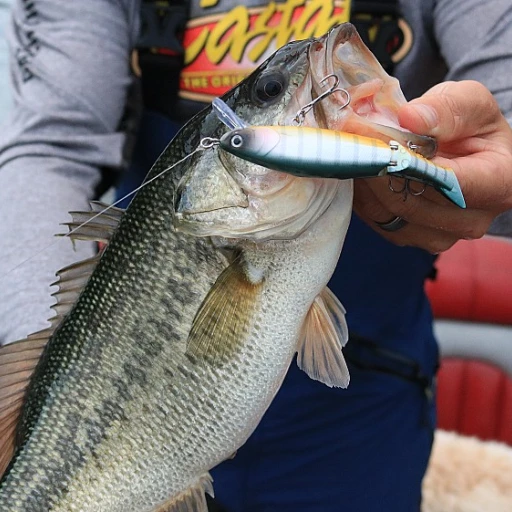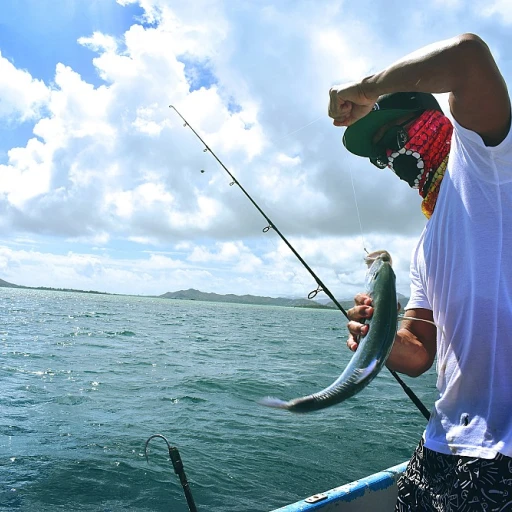
The giants of the deep: record-breaking fish
Legendary catches: a look at record-breaking giants
When it comes to fishing, there's nothing that gets the adrenaline pumping like hooking a true giant. And I mean the kind of fish that make headlines, the heavyweight champions of the aquatic world.
Let's take a look at some of the biggest fish caught, both in saltwater and freshwater—courtesy IGFA standards and real stories from passionate anglers.
The mighty Mekong giant catfish
This monster fish is no urban legend. The Mekong giant catfish is the true heavyweight of freshwater fish. Weighing up to an astounding 646 pounds (293 kg), this enormous whiskered beast was caught in Thailand in 2005, and it shatters all notions of what a freshwater fish can be.
These fish are native to the Mekong River, spanning several countries in Southeast Asia. But don't get too comfortable; catching one of these bad boys requires significant skill and patience.
The regal bluefin tuna
On the saltwater side, the bluefin tuna reigns supreme. This species is a favorite target for big-game anglers because it can reach immense sizes. Ken Fraser made history in 1979 when he caught a 1,496-pound (679 kg) bluefin off Nova Scotia, Canada. This catch remains a record that stands tall in the fishing world. Imagine reeling in a creature that big—not for the faint-hearted!
Mississippi river's behemoth blue catfish
Switching back to freshwater, you can't talk about giant catches without mentioning the blue catfish. These giants of the Mississippi River can weigh over 100 pounds. In fact, the record for the largest blue catfish stands at 143 pounds—a behemoth reeled in by Tim Pruitt in 2011.
Blue catfish have a reputation for being fierce fighters, making them an exciting catch for any angler with the right tackle and patience.
Get the full story and essential tips about these giants by reading our in-depth exploration of the giants of freshwater.
The great white shark: the king of the ocean
The great white shark: unmatched in size and power
When we think of the biggest fish caught in the world, the great white shark inevitably makes its way into our minds. These oceanic titans stand out not just because of their size but due to their sheer power and the fear they invoke in many. The great white shark (Carcharodon carcharias) holds numerous IGFA world records for being one of the most formidable sea creatures known to humankind.
A closer look at the giants
One of the most noteworthy catches was by Australian angler Alf Dean, who in 1959 caught a great white that tipped the scales at 2,664 pounds (1,208 kg) off the coast of Ceduna, South Australia. Using a rod and reel, Dean's catch remains one of the largest verified captures in recreational fishing.
What makes these sharks so massive?
Great whites can reach lengths of up to 20 feet (6 meters) and primarily feed on marine animals such as seals, sea lions, and even smaller whales. Their diet and the cold, nutrient-rich waters they inhabit help them grow to such extraordinary sizes. More interestingly, reports suggest these predators can live up to 70 years, giving them plenty of time to reach their colossal proportions.
Challenges and controversies
Despite their notoriety, capturing and recording a great white involves a gamut of challenges and legal considerations. Over the years, many countries have placed strict regulations to protect these sharks due to their declining numbers. This has sparked debates within the fishing community about conservation versus sportsmanship.
For those interested in the extensive records held by great white sharks and their impressive stature within the marine kingdom, the IGFA remains a critical resource to explore.
Bluefin tuna: the heavyweights of the sea
Bluefin tuna: the heavyweights of the sea
When it comes to the biggest fish caught in the world, the bluefin tuna holds a special place in the hearts of anglers. These creatures are not only massive but also considered some of the strongest fighters in the ocean. Their power and stamina make every encounter with them an exhilarating experience.
One of the most legendary tuna ever caught is the 1,496-pound bluefin tuna landed by Ken Fraser off Nova Scotia, Canada, in 1979. To this day, it remains the heaviest tuna ever recorded. According to the International Game Fish Association (IGFA), this monumental catch set the bar high for all aspiring tuna anglers. Imagine the raw force and determination it took to reel in a fish that could effortlessly drag a boat for miles!
The bluefin tuna, divided into three main species—Atlantic, Pacific, and Southern—roam the world's oceans. They are highly migratory, with some species traveling up to 6,000 miles, according to a study published in the journal Nature. Their size can be attributed to their constant movement; it's survival of the fittest in their high-energy world.
In game fishing circles, these colossal fish are often targeted in hotspots around the world. Places like Australia's Great Barrier Reef, the Gulf of Mexico, and Mediterranean Sea are prime spots for catching these giants. Each locale offers unique challenges, from bait selection to weather patterns, making every trip an adventure.
Anglers use specialized gear to battle these giants. Heavy-duty rod and reel setups, braided line, and large hooks are necessities. It's not uncommon for fights to last hours, testing the angler's resolve and physical stamina. The thrill of the fight and the prospect of landing a record-breaker drive fishermen to remote parts of the globe, always in search of the next big catch.
Looking deeper into the culture surrounding bluefin tuna fishing, it's clear that this sport goes beyond mere recreational fishing. For many, it's a rite of passage, a test of skill, and an opportunity to forge lifelong memories. Whether you're a seasoned pro or an aspiring angler, the allure of bluefin tuna is undeniable.
For those who want to experience the excitement and challenge of landing one of these oceanic giants, preparation and respect for the fish are key. Techniques vary, but the underlying passion remains the same. The world of bluefin tuna fishing is as vast and dynamic as the seas themselves.
Freshwater giants: the largest freshwater fish caught
Giant mekong catfish: a titan of the rivers
Get ready to be amazed by the enormous freshwater fish that lurk beneath our river waters. One of the most astonishing catches ever recorded is the Mekong giant catfish. Caught in northern Thailand in 2005, this colossal fish weighed an incredible 646 pounds (293 kg). Standing as one of the heaviest freshwater fish ever documented, it showcases just how fertile and rich Southeast Asia's river systems are.
The International Game Fish Association (IGFA) officially recognized this catch, marking a monumental achievement in the world of freshwater fishing. Mekong giant catfish are massive, with some legendary tales of them reaching lengths over 9 feet (2.7 meters). However, this specific catch, with its verified measurements, remains a testament to the sheer size these water giants can attain.
White sturgeon: ancient giants of North America
Another behemoth that frequently steals the limelight in freshwater records is the white sturgeon. This prehistoric fish has roots tracing back to millions of years. Often residing in the river systems of British Columbia and the Pacific Northwest states of the USA, these creatures can live for over a century and grow to lengths surpassing 20 feet.
An unforgettable catch took place in 1983 along the Fraser River in British Columbia, when a white sturgeon weighing 1,100 pounds (500 kg) and measuring 12 feet 4 inches (3.76 meters) was captured. Such figures are a stark reminder of the thriving aquatic biodiversity in North America, and provide fascinating insight into the lives of these ancient giants.
Wels catfish: Europe's monster of the deep
Europe is home to another freshwater titan: the wels catfish. Known for their elongated bodies and formidable size, these fish are often found across the continent, with Spain's River Ebro being particularly famous for housing some of the largest specimens. A standout moment in fishing history occurred in Italy when Alessandro Biancardi caught a wels catfish measuring 9 feet (2.74 meters) long and weighing in at 280 pounds (127 kg).
Both experts and enthusiasts alike are fascinated by the wels catfish due to their remarkable growth rates, aggressive behavior, and long lifespans. Reports suggest that these giant catfish can live over 60 years and continue to grow throughout their lifetimes, contributing to their massive sizes.
Nile perch: Africa's freshwater behemoth
We can't overlook Africa when discussing giant freshwater species. The Nile perch holds a special place among anglers for its impressive size and ferocious fight when hooked. Found in rivers and lakes throughout Africa, one of the most well-known locations is Lake Victoria.
In 2014, a Nile perch weighing 249 pounds (113 kg) was caught, showcasing their potential to reach tremendous sizes. Being a predatory fish, the Nile perch can grow over 6 feet (1.8 meters) and feature in numerous local legends and fishing stories across Africa.
The tiger shark: a formidable predator
A formidable predator: the tiger shark
The tiger shark, often regarded as one of the most formidable predators in the ocean, is known for its size and strength. With its distinctive dark vertical stripes on a bluish-green or gray body, this species has captured the attention of fishers and marine enthusiasts alike.
Tiger sharks can reach impressive sizes. According to the International Game Fish Association (IGFA), the largest tiger shark ever recorded weighed 1,785 pounds and was caught off the coast of Australia. This mammoth catch was made by Walter Maxwell in 1964 and has remained an unmatched record for decades.
These giants of the sea are found in multiple regions, primarily in tropical and subtropical waters. They're known for their powerful jaws, capable of crushing almost anything, including sea turtles and humans. Their indiscriminate feeding habits have earned them the nickname of the "garbage cans of the sea."
A notable record-breaker is the tiger shark caught by Kevin Barbara in 2004 in Hawaii. This fish weighed in at 1,450 pounds, demonstrating the incredible size and strength that characterize this species.
Experts often highlight the adaptability of tiger sharks as a primary reason for their pervasive presence and impressive sizes. Marine biologists like Dr. Samuel Gruber have studied the behavioral patterns of these sharks extensively, emphasizing their role in maintaining the balance of marine ecosystems. “Tiger sharks are apex predators that play a crucial role in keeping the ocean healthy by controlling fish populations,” says Dr. Gruber.
While encounters with tiger sharks can be thrilling, they are not without controversy. Incidents involving tiger sharks have sparked debates over the need for shark conservation versus the necessity of protecting human beachgoers. Despite the debate, it’s undeniable that the sheer size and power of the tiger shark continue to fascinate and challenge anglers worldwide.
Techniques for catching such a formidable predator vary, but most anglers agree that heavy-duty gear is essential. A strong rod and reel setup, reinforced with a wire leader, is critical to withstand the brute force of a tiger shark. Live bait, such as large fish or stingrays, is often used to entice these giants.
Recognizing the significance of these catches, organizations like the IGFA have been instrumental in documenting and verifying such feats. Their records offer a glimpse into the incredible world of big-game fishing, while also promoting sustainable practices to ensure the conservation of these majestic creatures.
The tiger shark remains a symbol of the awe-inspiring power of nature. For those who dare to challenge its might, the reward is a place in the annals of fishing history.
Greenland shark: the mysterious deep-sea giant
Greenland shark: the daunting deep-sea giant
Many fish have snagged headlines with their impressive sizes, but few are as mysteries as the Greenland shark. Known for their adaptation to icy waters, these ancient giants roam the Arctic and North Atlantic oceans.
Largest Greenland sharks caught
Among the biggest fish recorded, one of the weightiest Greenland sharks weighed in at a staggering 1,708 pounds (775 kg). This behemoth was caught off the coast of Norway. Numerous other specimens have been recorded through meticulous documentation by seasoned fishermen and scientific studies.
Predominantly enigmatic existence
What makes the Greenland shark standout isn’t just their massive size but their extraordinary long lifespan - some estimates suggest they might surpass 400 years in age! Dr. Julius Nielsen, a marine biologist, recounts in his studies how these sharks bring us closer to understanding deep-sea marine life and its astonishing lifespans.
Techniques for reeling in giants
To catch a Greenland shark, an extreme level of skill and patience is needed. Alessandro Biancardi, a renowned fisherman, shares that locating them often requires venturing into frigid waters, with immense depth: “Heavy-duty rod reels equipped with robust line and bait simulating their natural diet are vital,” he noted. Successfully catching these magnificent creatures often necessitates specialized equipment and expert know-how.
There's an intense respect among fishers for these titans. Unlike the agile great white shark, known as the king of the ocean, Greenland sharks are more elusive, requiring perhaps even more finesse to capture. The capture of one not only calls for brute strength but demands an emblematic understanding of their habitats.
”Fishing for Greenland sharks is almost like decoding a cryptic language of the fish world,” Ken Fraser, holder of multiple IGFA records, elucidated in one of his interviews. “It’s the rainbow at the end of a deep-sea treasure hunt.”
Techniques and tackle: how these giants were caught
Techniques and tackle: how these giants were caught
Mastering the appropriate gear and tackle
Imagine reeling in a fish that weighs hundreds of pounds—that's no simple feat! Every legendary catch, from Ken Fraser's 1,496-pound Atlantic bluefin tuna in Nova Scotia to Alessandro Biancardi's impressive wels catfish in Italy, required specialized gear and tackle. Not just any rod and reel will do; these anglers relied on top-notch, heavy-duty equipment specifically designed to handle the sheer power and size of these giants. For instance, Fraser’s record bluefin tuna catch was achieved using a rod and reel capable of handling intense strain and pressure.
Strength and technique
Strength and patience play pivotal roles in successfully landing these massive fish. It's not uncommon for battles to last several hours, testing the angler's endurance and skill. Ken Fraser spent over 45 minutes fighting his massive tuna before successfully landing it. Greenland sharks, known for their mysterious deep-sea lives, often require a mix of brute strength and precise technique, as their immense weight and power can easily outmatch standard gear if not handled correctly.
Bait and lures: the essential ingredients
The choice of bait or lure is crucial. Many record-shattering catches, such as the king of the ocean, the great white shark, were tempted with large, natural baits like chunks of fish or squid. In the case of fly fishing for smaller yet significant freshwater giants, specialized flies that mimic the natural food sources of the specific fish species were employed. For example, Alessandro Biancardi's famous wels catfish was lured in using large, robust baits that attracted the giant catfish lurking in European rivers.
Determination meets experience
Veteran anglers often rely on their deep pool of experience and knowledge. Understanding the species' behavior, preferred habitats, and feeding patterns can significantly increase the chances of a successful catch. For example, Biancardi's years of experience fishing in Italy's Po River helped him master the art of baiting and reeling in the truly biggest fish.
The magic of fishing locations
Location is key. The waters off the coast of Florida, known for their thriving population of tiger sharks and bluefin tuna, and the pristine regions of Norway, home to Greenland sharks, reveal how diverse locations contribute to record-breaking fishing. This knowledge allows anglers to pick and prepare the right tackle, making the dream of landing a giant a reality.
The unseen heroes: boats and crews
Small details matter, like the type of boat used and the skills of the crew. In many instances, the crew's expertise plays a massive role in successfully landing these fish. Safe navigation and positioning, as well as helping the angler manage the fish’s enormous power, can be as crucial as the tackle used.From customized heavy-duty gear to the right bait, tackling these magnificent giants demands a mix of technique, strength, and deep-seated knowledge. Each record-breaking catch tells a story of dedication, expertise, and sometimes, a bit of luck.
The role of the International Game Fish Association (IGFA)
The IGFA's mission and contributions
The International Game Fish Association (IGFA) has been a cornerstone in the recreational fishing community since its founding in 1939. This non-profit organization is dedicated to the conservation of game fish and the promotion of responsible, ethical angling practices. But the IGFA is perhaps best known for its meticulous record-keeping of the world's largest and most impressive fish caught.
Setting the gold standard in record-keeping
One of the IGFA's most critical roles is maintaining a vast database of world records. Fishing enthusiasts from all over the globe vie to have their catches recognized by the IGFA, ensuring strict adherence to the organization's rules and regulations. To this day, the IGFA has documented thousands of records, including giants like Ken Fraser's 1,496-pound Atlantic bluefin tuna, caught in Aulds Cove, Nova Scotia in 1979, and the elusive 2,664-pound great white shark caught by Alfred Dean in Ceduna, Australia in 1959.
Ensuring fair play and ethical standards
The IGFA's guidelines are designed to ensure fairness and integrity in the recording of fishing records. To qualify for a record, the fish must be caught according to specific rules, such as the use of rod and reel and no assistance from anyone else during the catch. The IGFA has also pushed for barotrauma reduction practices, catch-and-release protocols, and the use of circle hooks to minimize unnecessary harm to fish species.
Promoting sustainable fishing practices
Beyond record-keeping, the IGFA is heavily involved in conservation efforts. They collaborate with various marine and freshwater conservation organizations to protect aquatic ecosystems and ensure the longevity of fish populations. For instance, their Fish for the Future campaign emphasizes sustainable fishing practices, highlighting the importance of bag limits and responsible catch and release.
Community and education programs
The IGFA also invests in community engagement through educational initiatives. Programs like the Passports to Fishing and the Junior Angler Program aim to educate young anglers on sustainable fishing techniques and the science behind marine conservation. The intent is to foster a new generation of fishers who care deeply about preserving marine life.
Recognizing ethical angling
The IGFA celebrates anglers who make exceptional catches while adhering to ethical guidelines. Their annual World Record Game Fishes book is one way in which they highlight these achievements. Each record in the book comes with the story behind the catch, often revealing the challenges and triumphs faced by the angler. Stories like Alessandro Biancardi's epic battle with the 285-pound wels catfish in the River Po, Italy, in 2015, inspire and educate the fishing community about the importance of responsible fishing practices.
Continually evolving standards
The IGFA continually updates its standards and practices to reflect the latest conservation science and ethical angling techniques. For example, they have recently included categories for fly fishing records and have started to heavily promote the use of biodegradable fishing tackle. These efforts ensure that the IGFA remains at the forefront of promoting both the sport of fishing and the conservation of fish species worldwide.
In conclusion, the IGFA's role extends far beyond just maintaining world records. Their efforts in promoting sustainable fishing practices, ethical angling standards, and community education make them a pivotal part of the global fishing community. They are the gold standard for anyone who dreams of landing the biggest fish caught in the world.

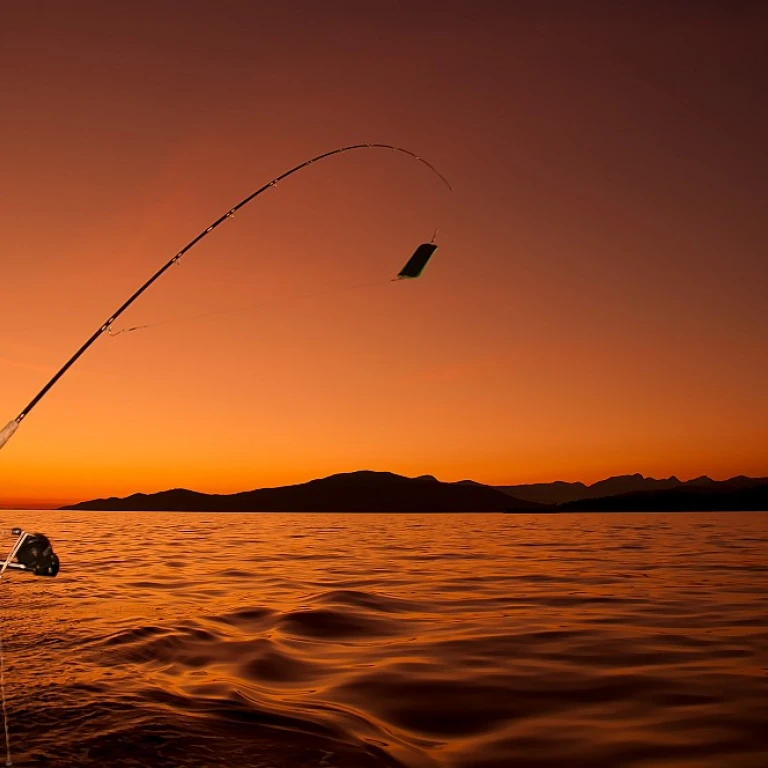


-large-teaser.webp)
-large-teaser.webp)
